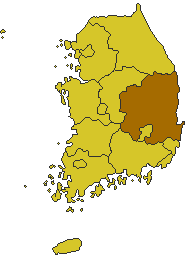| Mungyeong Massacre | |
|---|---|
 North Gyeongsang, South Korea. | |
| Location | South Korea |
| Date | December 24, 1949 [1] |
| Target | Communist sympathizer civilians |
Attack type | Massacre |
| Deaths | 86[1][2][3]–88[4][5] |
| Perpetrators | Syngman Rhee anticommunist forces |
The Mungyeong Massacre[1] (Korean: 문경 양민학살 사건; Hanja: 聞慶良民虐殺事件[3]) was a massacre conducted by 2nd and 3rd platoon, 7th company, 3rd battalion, 25th Infantry Regiment, 3rd Infantry Division of the South Korean Army on 24 December 1949 of 86 to 88 unarmed citizens in Mungyeong, North Gyeongsang district of South Korea, all of whom were civilians and a majority of whom were children and elderly people.[2][4][3][5] The victims included 32 children.[3] The victims were massacred because they were suspected communist supporters or collaborators.[2][6] However, the South Korean government blamed the crime on communist guerrillas for decades.[1][5]
On 26 June 2006, the Truth and Reconciliation Commission of South Korea concluded that the massacre was committed by the South Korean Army.[5] However, a South Korean local court decided that charging the South Korean government with the massacre was barred by statute of limitations, as the five-year prescription ended in December 1954.[1] On 10 February 2009, the South Korean high court also dismissed the victim's family complaint.[5][6][1] In June 2011, the Supreme Court of Korea decided that the South Korean government should compensate victims of the inhumane crimes it had committed regardless of the deadline to make the claim.[1]
YouTube Encyclopedic
-
1/2Views:2 5081 726
-
History - Takeshima / No Dokdo in the old maps anywhere
-
Propaganda song
Transcription
See also
- Truth and Reconciliation Commission (South Korea)
- Bodo League massacre
- Jeju Uprising
- List of massacres in South Korea
References
- ^ a b c d e f g "Compensation claim period limitless for inhumane state crimes". The Korea Times. 9 August 2011. Retrieved 28 September 2012.
- ^ a b c Jeong Hee-san (13 January 2000). 문경 양민 학살 진실 밝혀질까 문경 양민 학살 유족들, 헌법 소원 내기로…정부, 50년 동안 외면. Sisapress (in Korean). Retrieved 30 November 2011.
- ^ a b c d '문경 양민학살 특별법' 제정 청원. JoongAng Daily (in Korean). 16 August 2004. Retrieved 8 July 2010.
- ^ a b 민간인학살 울산-문경 두 판결문 비교. 경남도민일보 (in Korean). 16 February 2009. Retrieved 8 July 2010.
- ^ a b c d e 두 민간인 학살 사건, 상반된 판결 왜 나왔나?'울산보도연맹' - '문경학살사건' 판결문 비교분석해 봤더니.... OhmyNews (in Korean). 17 February 2009. Archived from the original on 3 May 2011. Retrieved 8 July 2010.
- ^ a b '과거사 사건' 12건 배상액 1810억원. The Chosun Ilbo (in Korean). 26 October 2009. Retrieved 8 July 2010.
External links
- (in Korean) 국가범죄 '문경학살사건' 항소심서도 패소 판결 CBS 2009-08-06
36°43′26″N 128°12′44″E / 36.72389°N 128.21222°E
